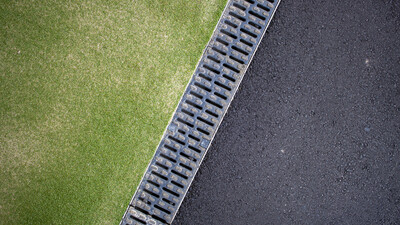Poor drainage can turn a garden into a waterlogged mess, creating muddy patches, killing plants and even damaging nearby structures. Installing a channel drain is one of the most effective ways to manage excess water, but with various types available, selecting the right one requires careful consideration. Let’s explore common garden drainage challenges, compare channel drains with alternative solutions, and understand the benefits of choosing the right system.
Effective Drainage: The Secret to a Healthy Garden
A poorly drained garden or landscaped area will develop a host of problems. If hard-landscaped areas such as paths and patios aren’t drained efficiently, they can attract moss that is both unsightly and slippery when wet. If water on stone or concrete surfaces freezes, it can cause the material to crack or crumble; again, this is unsightly and a safety hazard and greatly reduces the material’s lifespan.
Some soil types, such as those with a high clay content, don’t naturally drain easily. Waterlogged soil is more prone to erosion and flooding. Well-drained soil maintains healthy plant roots and prevents moss growth on lawns.
Landscape Drainage Solutions: How Channel Drains Compare
Various methods can be used to drain excess water from hard and soft landscaping, each having specific benefits. Take for example the combination of a French drain and a soakaway.
French Drains
The buried perforated pipe of a French drain is ideal for extracting high volumes of water from a large area of soil, directing it to a soakaway pit for gradual release. This works especially well if the soil being drained is relatively porous, as the water must penetrate the soil before it can be removed.
Gully traps
Surface water can be removed from hard landscaping via a gully trap. This features a small, square or round chamber sunk below the surface at the lowest point of a section of hard landscaping and covered by a grating. Connected to either a storm drain or a soakaway via a length of pipework, a gully trap is particularly useful for removing surface water from low points in hard landscaping that would otherwise be prone to flooding.
Channel Drains
A channel drain performs in a similar manner to a gully trap, except that it extracts water from a long, narrow strip of hard or soft landscaping. This means it can quickly remove a higher volume of surface water from a larger area and requires less complex groundwork preparation to ensure runoff to a specific point.
A channel drain can also create a complete barrier against water runoff. Two examples of this are:
- A channel drain placed across the threshold of a garage door. If a driveway slopes towards the garage, the channel drain prevents rain from crossing the threshold and flooding the garage.
- A channel drain laid along the boundary between hard and soft landscaping. If rainwater runs off a large area of non-porous hard landscaping onto loose soil, a channel drain can protect soil against waterlogging, erosion and loss of nutrients.
Channel Drains: Their Aesthetic and Technical Benefits
One of the main advantages of channel drains is their ability to blend seamlessly into garden designs. Modern designs feature sleek, discreet grates available in various materials and finishes, ensuring they complement different landscaping styles. Whether you prefer a contemporary stainless-steel grate or the darker tones of ductile iron to blend effortlessly with more classic and traditional landscaping, there’s an option to match your outdoor aesthetic.
From a technical perspective, channel drains offer an efficient and low-maintenance solution. Their linear design captures water over a wide surface area and directs it into an underground drainage system, preventing pooling and erosion. Removable grates make them easy to clean and maintain over time.
The Right Channel Drain: A Material Difference
The materials that a channel drain and its grating are made from have a crucial role in performance and appearance.
Plastic channel drains are lightweight, easy to install and cost-effective, making them a popular choice for DIY projects. However, they may not be as durable as other options.
Polymer concrete drains, on the other hand, are incredibly strong and resistant to wear, ideal for long-term performance.
Stainless steel grates offer a modern, high-end look and are highly resistant to corrosion, while cast or ductile iron grates provide a traditional aesthetic with excellent durability.
When choosing the material, consider the surrounding environment and how much foot traffic or garden maintenance it will endure. For most domestic gardens, a polymer concrete channel with a decorative stainless steel or plastic grate offers the best balance between durability and aesthetics. If the channel drain is to be in a location where it could be traversed by vehicles, a stronger option may be required.
If this is the first time you are specifying or installing a channel drain in a garden or landscaping environment, free and impartial advice from a drainage expert is invaluable and could save you a lot of time and money.
At Drainfast, we have a large team of drainage product professionals with extensive experience in specifying and installing channel drains, and they are here to help you. Simply call 01420 555600 or leave a message on our online contact page for professional, impartial advice.

Written by
Bob Stone
Technical Sales
Heading up our Technical Estimating Department, Bob is our in-house quantity surveyor.

